
Parameter
Mehr zum Buch
The present work is providing some of the last results of a research conducted on thin films of carbon-rich crystalline silicon, which contribute to the improvement of the future generation of silicon-germanium hetero-bipolar transistors. Even if the carbon solubility is extremely low in silicon, it is shown that few percents can be achieved without defects using molecular beam epitaxy. Depending on the growth conditions, different defects may appear and are studied here. In addition to this systematic effort, the influence of carbon atoms on the diffusion of common dopants, namely boron and antimony, is described. A model for diffusion is presented, including the problems of precipitation to offer a good fit of experimental data, after long annealing time. The stresses involved by the carbon incorporation in silicon are used in an original way to change the crystal lattice parameters. Therefore it is shown that high carbon concentrations may be advantageous in silicon for the control of dopant diffusion and the engineering of the silicon lattice.
Buchkauf
Carbon rich crystalline silicon, Pierre Y. Lavéant
- Sprache
- Erscheinungsdatum
- 2001
- product-detail.submit-box.info.binding
- (Paperback)
Lieferung
Zahlungsmethoden
Feedback senden
- Titel
- Carbon rich crystalline silicon
- Sprache
- Englisch
- Autor*innen
- Pierre Y. Lavéant
- Verlag
- Tenea
- Erscheinungsdatum
- 2001
- Einband
- Paperback
- ISBN10
- 3936582408
- ISBN13
- 9783936582406
- Reihe
- Tenea Wissenschaft
- Kategorie
- Skripten & Universitätslehrbücher
- Beschreibung
- The present work is providing some of the last results of a research conducted on thin films of carbon-rich crystalline silicon, which contribute to the improvement of the future generation of silicon-germanium hetero-bipolar transistors. Even if the carbon solubility is extremely low in silicon, it is shown that few percents can be achieved without defects using molecular beam epitaxy. Depending on the growth conditions, different defects may appear and are studied here. In addition to this systematic effort, the influence of carbon atoms on the diffusion of common dopants, namely boron and antimony, is described. A model for diffusion is presented, including the problems of precipitation to offer a good fit of experimental data, after long annealing time. The stresses involved by the carbon incorporation in silicon are used in an original way to change the crystal lattice parameters. Therefore it is shown that high carbon concentrations may be advantageous in silicon for the control of dopant diffusion and the engineering of the silicon lattice.